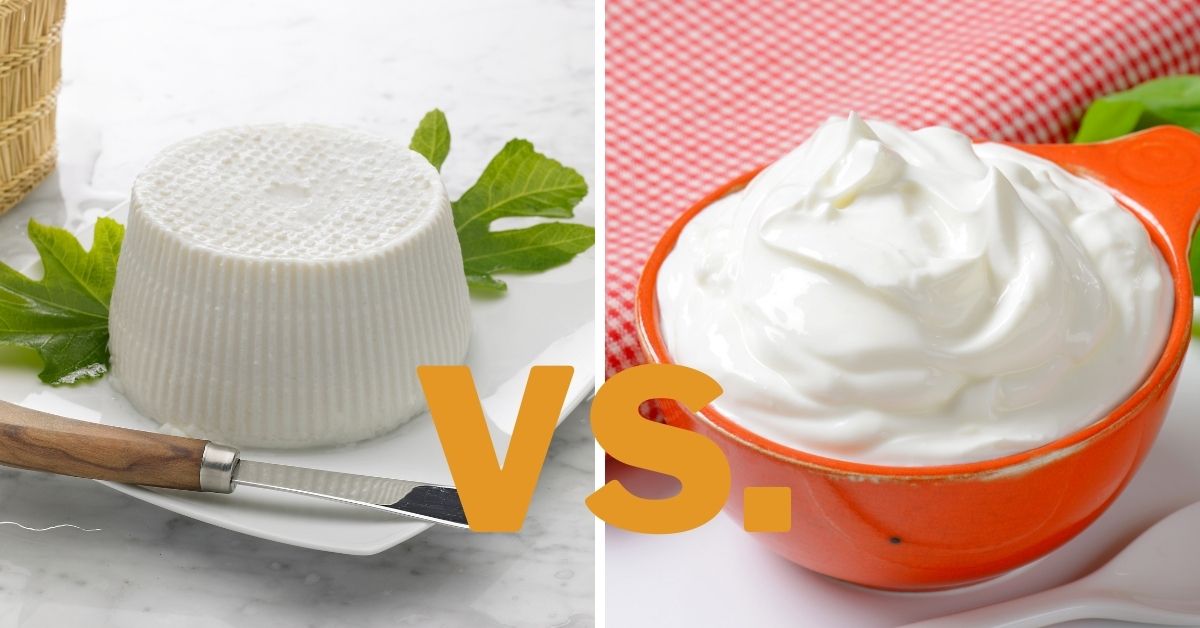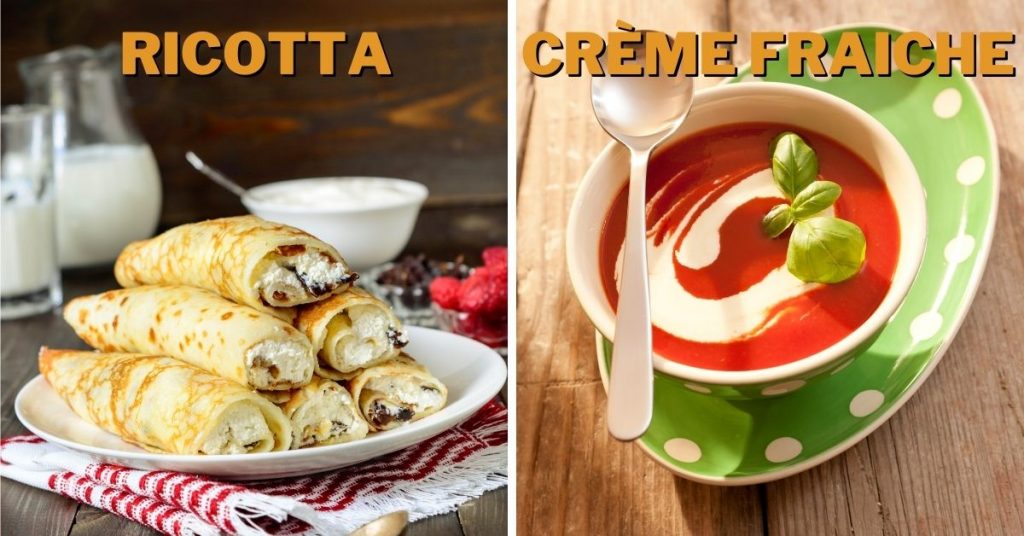Ricotta vs. Crème Fraiche: Differences & Which Is Better?

Although similar in taste, structure, and appearance, ricotta and crème fraiche are two different dairy products. Both are widely used and find their place in many dishes and cuisines, but sometimes they can substitute one another. So, what are the differences between ricotta and crème fraiche and which is better?
Creme fraiche are two different dairy products. Ricotta is a cheese made of coagulated milk, while crème fraiche is a type of sour cream made of heavy cream. Ricotta is grainy, and crème fraiche is smooth and buttery. While ricotta is often used in desserts, crème fraiche is used for savory dishes.
Personally, I am more inclined toward crème fraiche, but my personal preference isn’t a measure as to which one of these products is better. They both come with their strengths and weaknesses and deserve to be properly paired, as they give their best when combined well. The following paragraphs will explain the differences between ricotta and crème fraiche, their uses, tastes, and textures.
Ricotta vs. Crème Fraiche: Differences
Ricotta and crème fraiche are two different dairy products and are obtained through double milk processing.
Ricotta, which means “recooked,” is a type of cheese obtained through coagulation of the leftover milk used to produce other cheeses. Therefore, it can be made of sheep’s, cow’s, buffalo’s, or goat’s milk.
Crème fraiche is made from heavy cream. Heavy cream is similar to buttermilk, and it is the fatty part of the milk that separates at high temperatures. To obtain crème fraiche, the heavy cream is cultured with Lacto bacteria that trigger the fermentation process.
As secondary milk products, ricotta and crème fraiche have retained some features of their root ingredients but have also developed new characteristics due to their production processes.
Nutrition
Although the ricotta’s fat and calorie content vary depending on the type of milk from which the cheese was obtained, it is still less fatty and caloric than crème fraiche. However, they are both high-fat and high-calorie products.
In terms of nutritional value, ricotta is much more nutritious compared to crème fraiche. Ricotta is still considered a healthy cheese despite its high-fat amount if you consume it moderately and in smaller amounts.
Ricotta contains good amounts of vitamins such as vitamin A, B2, B12, B6, B1, B5, E, K, and folate. It also includes magnesium, calcium, selenium, phosphorous, zinc, potassium, sodium, iron, and copper. [1]
Ricotta also contains omega 3 and omega 6 fatty acids and a lower lactose amount than other dairy products.
Because ricotta is high in protein, you should be careful if you have a protein allergy, and because it is high in fat and calorie, you should pace yourself if you suffer from high cholesterol.
Crème fraiche, on the other hand, is fattier than ricotta because its root ingredient is heavy cream. Also, considering that the milk is processed twice before obtaining the final product, it hasn’t retained much of the milk’s nutrients.
However, the Lacto bacteria added to the heavy cream make crème fraiche very beneficial for gut health, and the significant amount of calcium makes it good for the bones. Still, other than these, crème fraiche doesn’t offer other health benefits or contain additional nutrients.
Crème fraiche is a good choice for a low-carb diet, though you shouldn’t consume it often because of its high-fat content.
Taste
Both ricotta and crème fraiche fall into the neutral-tasting category but still have distinctive tastes. They are both fresh, creamy, slightly sour, and mildly salty.
Ricotta is a bit tangy, which is natural because it’s a type of cheese, and crème fraiche is buttery and creamy since it is a type of cream. However, crème fraiche can remind you of cream cheese, while ricotta does not so much.
The most expressed taste feature in these products is their explicit freshness. Both are rich and discretely sweet and work amazingly as additions to sweet as well as savory dishes.
Texture
Creamy and buttery, crème fraiche seduces the dish with its softness. It has an overall smooth and silky structure and is stable and thick. It would slide off rather than drip.
Ricotta is mostly smooth and soft cheese but a bit grainy as well. Since it is strained and not pressed, the ricotta curds contain more water as water is their only binder.
Ricotta and crème fraiche are both creamy, tender, and spreadable, but crème fraiche is milkier than ricotta.
Uses
Nowadays, ricotta and crème fraiche are regularly used worldwide. In fact, they are some of the most common dairy products.
Although crème fraiche originated in France, it is now a frequent visitor to many kitchens, as it is easy to make at home. Ricotta originated in Italy, and its purpose was to repurpose the leftover milk so that it isn’t wasted.
Ricotta and crème fraiche have found their place in modern cuisine, and their use evolves alongside the culinary trends.
Crème fraiche is well known for its use as fresh salad dressing, spread for baked goods, in soups, and berry smoothies. It also works great as an addition to omelets, as a dip, or as a sauce thickener.
Fruit salads are also excellent for crème fraiche, as well as cheesecakes and fruity desserts.
Just like crème fraiche, ricotta also works excellent with omelets, as a dip, and on top of baked goods, but you can fry and bake it as well. Ricotta fritters or baked ricotta is a delight and combined with fried vegetables, it becomes a decadent culinary experience.
Ricotta also does very well as a pancake topping, cheesecake filling, and as an addition to pasta sauces.

Ricotta Vs. Crème Fraiche: Which Is Better?
Ricotta and crème fraiche have similar and different uses and similar structures, and depending on your taste, they can both do a great job. To answer which one is better, I would say crème fraiche.
Crème fraiche is more flavorful and richer than ricotta. You can use it in more dishes that will immediately get enriched after adding crème fraiche to them.
However, bear in mind that crème fraiche is more caloric than ricotta, so moderate usage would be more appropriate than everyday use.
Can You Substitute Crème Fraiche for Ricotta?
Considering that crème fraiche is more neutral than ricotta, it does a great job as a ricotta substitute in pasta sauces, cheesecake filling, and dips. Still, you cannot substitute crème fraiche for ricotta if you want to have fried or baked ricotta.
Can You Substitute Ricotta for Crème Fraiche?
Ricotta can substitute for crème fraiche in cheesecakes and pasta sauces, but it cannot fit into smoothies or make a smooth salad dressing. Because of its slightly tangy taste and mildly grainy texture, ricotta can substitute less for crème fraiche than vice-versa.
Ricotta Vs. Crème Fraiche for Lasagna?
Because ricotta is delicious when baked, it is the best choice for lasagna. If you make your lasagna with crème fraiche, it wouldn’t be creamy and rich but watery and probably bland.
Ricotta Vs. Crème Fraiche for Pasta?
It depends on your preference, as both can be an excellent addition to pasta sauces. Crème fraiche is well known for its use as a pasta sauce thickener, and ricotta has a reputation for bringing zest and playfulness to the pasta.
Ricotta Vs. Crème Fraiche for Sauces?
Crème fraiche is better to use for the sauce. Because it is creamy and neutral, it works in any type of sauce. Ricotta is also a good choice, but it won’t blend in the sauce as crème fraiche would, but still, it melts better than other cheeses.
Ricotta Vs. Crème Fraiche for Desserts?
As a cheesecake filling or dessert topping, both crème fraiche and ricotta are good choices. Their neutral and rich tastes, combined with their creaminess and softness, make both these products suitable for desserts.
However, ricotta is more often used as a cream, and crème fraiche is more often used as topping for cheesecake.
Ricotta Vs. Crème Fraiche for Soups?
Crème fraiche is famous for its use in soups because it melts and thickens the soup. Still, ricotta wouldn’t be the worst decision here, but it cannot compare to the creaminess that crème fraiche provides.
